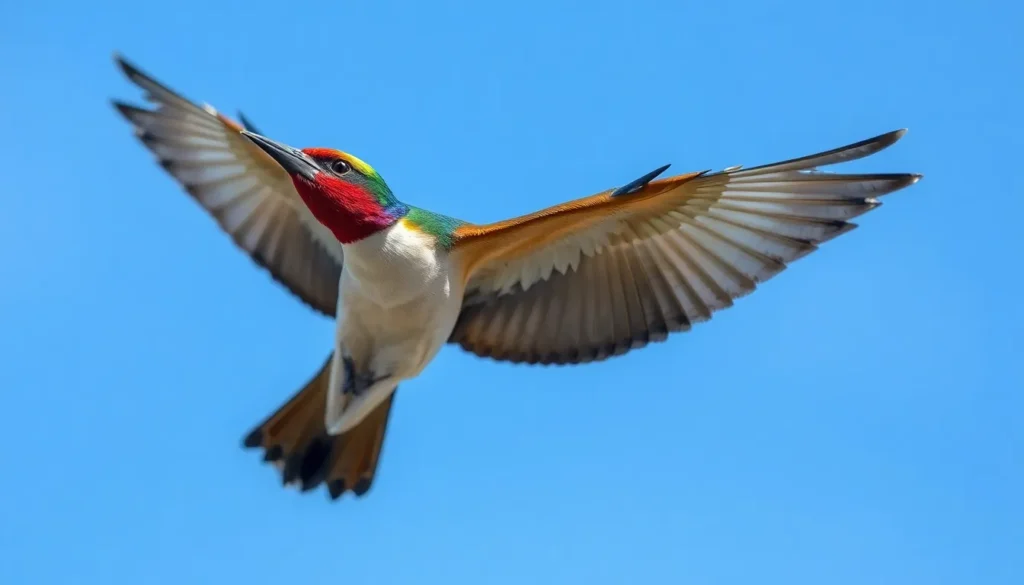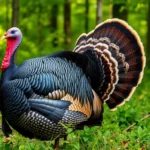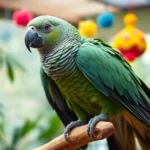When we marvel at a bird soaring effortlessly through the sky or diving gracefully into water we’re witnessing millions of years of evolutionary perfection in action. Bird anatomy represents one of nature’s most remarkable engineering achievements combining lightweight construction with incredible functionality.
Every feather bone and organ in a bird’s body serves a exact purpose that enables flight survival and reproduction. From their hollow bones that reduce weight without sacrificing strength to their highly efficient respiratory system that processes oxygen during both inhalation and exhalation birds have evolved extraordinary adaptations that set them apart from all other animals.
Understanding bird anatomy isn’t just fascinating—it’s essential for anyone interested in ornithology wildlife conservation or simply appreciating the incredible diversity of our feathered friends. We’ll explore the intricate systems that make birds such successful creatures and discover why their unique anatomical features continue to inspire engineers and scientists worldwide.
Basic Bird Body Structure
Bird anatomy follows a consistent structural framework across all species while accommodating remarkable diversity in form and function. We observe this fundamental design in every bird species from tiny hummingbirds to massive ostriches.
External Features and Body Regions
Birds organize their external anatomy into distinct regions that serve exact functions for survival and flight. The head houses critical sensory organs including eyes, ears, and the bill which varies dramatically based on feeding habits. Eagles possess sharp hooked bills for tearing meat while finches display short conical bills for cracking seeds.
The neck connects the head to the torso and contains 13-25 vertebrae depending on the species. Swans have 25 cervical vertebrae allowing extraordinary flexibility while most songbirds contain 13-14 vertebrae. This region enables birds to rotate their heads up to 270 degrees in some owl species.
Wings attach to the torso and consist of three main sections: the primary flight feathers on the outer wing, secondary feathers closer to the body, and coverts that streamline airflow. These structures work together to generate lift and provide maneuverability during flight.
The torso houses vital organs within a streamlined body cavity protected by the sternum and rib cage. Legs extend from the lower torso and terminate in feet adapted for exact environments. Webbed feet assist swimming in ducks while talons enable hunting in raptors.
The tail provides stability during flight and serves as a rudder for directional changes. Tail feathers also play roles in courtship displays and species recognition.
Size and Shape Variations Across Species
| Size Category | Weight Range | Wing Span | Examples |
|---|---|---|---|
| Smallest Birds | 1.6-2.5 grams | 5-6 inches | Bee Hummingbird |
| Small Birds | 10-50 grams | 6-12 inches | House Sparrow, Goldfinch |
| Medium Birds | 100-500 grams | 20-36 inches | Robin, Blue Jay |
| Large Birds | 1-5 kg | 4-6 feet | Bald Eagle, Pelican |
| Largest Birds | 40-150 kg | 6-11 feet | Ostrich, Condor |
Body proportions reflect ecological adaptations across different bird families. Seabirds like albatrosses develop elongated wings spanning up to 11 feet for efficient gliding over ocean surfaces. Forest birds such as woodpeckers possess short rounded wings that enable quick maneuvering between tree branches.
Ground dwelling birds including chickens and quail exhibit robust leg muscles and reduced flight capabilities. Their bodies prioritize terrestrial locomotion over aerial mobility. Conversely, aerial specialists like swifts display swept back wings and streamlined bodies optimized for continuous flight.
Beak variations demonstrate remarkable specialization across species. Pelicans feature expandable throat pouches for scooping fish while hummingbirds possess needle like bills for accessing flower nectar. Crossbills develop asymmetrical mandibles specifically adapted for extracting seeds from conifer cones.
These anatomical variations represent millions of years of evolutionary refinement customized to exact ecological niches and survival requirements.
The Avian Skeletal System

The avian skeletal system represents one of nature’s most sophisticated engineering marvels, perfectly balancing strength with minimal weight. Our exploration of this remarkable framework reveals how bones evolved specifically to support flight while maintaining structural integrity.
Lightweight Bone Adaptations
Pneumatic bones form the foundation of avian flight capability through their hollow internal structure. Air sacs extend into these bones, creating a network of spaces that reduces overall body weight by up to 20% compared to solid bone equivalents. Major bones including the humerus, sternum, and vertebrae contain these air filled cavities without compromising their load bearing capacity.
Cortical bone walls in birds measure significantly thinner than mammalian counterparts while maintaining exceptional strength through strategic calcium phosphate distribution. Cross sectional analysis shows that bird bones achieve strength to weight ratios exceeding those found in aircraft aluminum structures. Trabecular bone patterns inside avian bones create internal support struts that distribute mechanical stress efficiently during flight maneuvers.
Bone density variations occur throughout the skeleton based on functional demands. Flight bones maintain lower density values of 1.8 to 2.2 grams per cubic centimeter compared to mammalian bone density of 2.6 grams per cubic centimeter. Weight distribution concentrates in the torso region where the largest flight muscles attach, creating optimal balance for aerial locomotion.
Wing and Flight Related Bone Structure
The wing skeleton consists of three primary segments that mirror the basic vertebrate limb pattern while incorporating flight exact modifications. Humerus bones connect to reinforced shoulder joints capable of withstanding forces up to 8 times body weight during powered flight. Radius and ulna bones in the forearm region maintain parallel alignment to support primary flight feathers along their length.
Carpometacarpus bones represent fused hand elements that create a rigid platform for wing tip feathers essential to flight control. These bones eliminate unnecessary joints while providing attachment points for alula feathers that prevent wing stalling at low speeds. Phalanges remain only as remnants supporting the thumb wing or bastard wing structure.
Sternum modifications include an enlarged keel that provides attachment surfaces for massive pectoral muscles generating flight power. This breastbone extension can account for up to 25% of total body weight in strong flying species like hummingbirds and falcons. Coracoid bones act as structural braces connecting the sternum to the shoulder joint, preventing chest collapse during the powerful downstroke of flight.
Wishbone or furcula formation results from fused clavicles that store and release elastic energy during the flight cycle. This bone flexes outward during wing upstrokes and springs back during downstrokes, contributing up to 15% of total flight power in some species. Scapula positioning along the back creates optimal leverage points for flight muscle attachment.
Skull and Beak Variations
Avian skulls demonstrate remarkable diversity while maintaining consistent lightweight construction principles across all species. Bone fusion eliminates most skull sutures found in other vertebrates, creating single unit strength without excess weight. Pneumatization extends throughout skull bones including the frontal, parietal, and temporal regions in larger bird species.
Beak structure directly reflects feeding ecology through specialized bone shapes and densities. Seed eating finches possess thick, conical beaks with reinforced jaw muscles and robust skull attachments. Fish eating herons display elongated, spear like beaks with flexible neck vertebrae enabling rapid strike movements. Nectar feeding hummingbirds evolved thin, curved beaks matching flower shapes with corresponding skull modifications.
Brain case proportions vary significantly among bird groups based on cognitive demands and sensory processing requirements. Corvids like ravens and crows possess enlarged brain cases accommodating complex neural structures, while many seabirds maintain smaller brain cases relative to body size. Eye socket dimensions reflect visual acuity needs, with raptors showing proportionally larger orbital bones than ground dwelling species.
Nostril positioning and internal nasal structure adaptations appear throughout different bird families. External nares location varies from the base of the beak in most songbirds to tube like extensions in seabirds like petrels and albatrosses. Internal turbinate bones increase surface area for air processing and scent detection in species with enhanced olfactory capabilities.
Muscular System and Flight Mechanics

Birds possess one of nature’s most sophisticated muscular systems, engineered specifically for the demanding physics of powered flight. We examine how these specialized muscle groups coordinate with respiratory functions to create the remarkable aerial capabilities that define avian success.
Flight Muscles and Wing Movement
Flight muscles comprise up to 35% of a bird’s total body weight in strong flying species like hawks and eagles. The pectoralis major serves as the primary downstroke muscle, generating the powerful force needed to drive wings through air during the critical lift-generating phase. Located beneath this massive muscle, the supracoracoideus creates the upstroke motion through an ingenious pulley system that redirects muscle contraction upward via the triosseal canal.
Fast-twitch muscle fibers dominate flight muscle composition, enabling rapid wing beat frequencies that range from 5 beats per second in large raptors to over 80 beats per second in hummingbirds. These fibers contain exceptionally high concentrations of mitochondria, often comprising 40% of muscle cell volume compared to just 5% in typical mammalian muscle tissue.
Wing control extends beyond simple up and down movements through intricate coordination of smaller muscle groups. Deltoid muscles adjust wing angle and position, while the patagialis muscles control the tension of wing membranes between bones. Coracobrachialis muscles provide fine-tuned adjustments to wing rotation, allowing birds to execute precise maneuvers during flight.
Modern flight analysis reveals that muscle activation patterns vary dramatically between different flight modes. Soaring birds like albatrosses minimize energy expenditure by using specialized locking mechanisms in their wing joints, reducing active muscle engagement by up to 90% during gliding phases.
Respiratory Muscle Coordination
Respiratory muscles synchronize precisely with flight muscles to maintain the oxygen-rich blood flow essential for sustained aerial activity. The intercostal muscles between ribs create the primary breathing motion, expanding and contracting the thoracic cavity in coordination with wing beats at ratios that optimize gas exchange efficiency.
Diaphragmatic muscles in birds function differently from mammals, working in concert with air sac muscles to create the unidirectional airflow through the lung system. These muscles contract in alternating patterns that maintain continuous oxygen delivery even during the most energy-intensive flight phases.
Expiratory muscles including the internal intercostals and abdominal muscles generate the pressure differentials necessary to force air through the complex network of air sacs. Research shows these muscles can increase breathing efficiency by 300% compared to mammalian respiratory systems during equivalent metabolic demands.
Accessory respiratory muscles provide additional breathing capacity during extreme flight conditions. The scalene and serratus muscles assist in emergency oxygen intake, while specialized muscles around the air sacs create the precise pressure changes needed for optimal gas exchange across different altitudes and flight intensities.
Respiratory System Adaptations
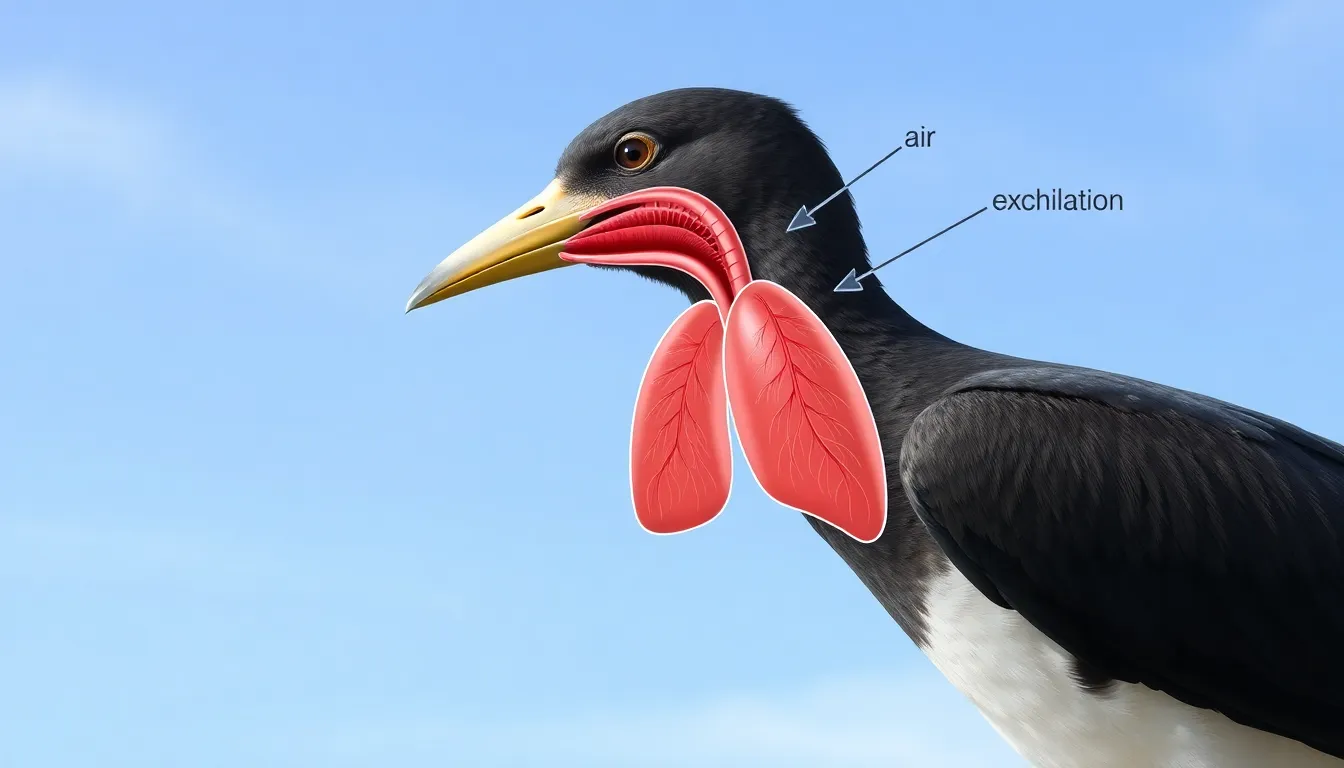
Birds possess the most efficient respiratory system among vertebrates, featuring unique anatomical structures that maximize oxygen uptake during flight. This sophisticated network of air sacs and specialized breathing mechanisms enables sustained high-energy activities that would be impossible with mammalian respiratory systems.
Air Sacs and Breathing Efficiency
Air sacs represent the most distinctive feature of avian respiratory anatomy, comprising 9 interconnected chambers that extend throughout the bird’s body. These thin-walled structures occupy approximately 20% of total body volume and connect directly to hollow bones, creating an integrated pneumatic system.
Primary air sacs include the cervical, interclavicular, and anterior thoracic chambers, which receive fresh air during inhalation. Secondary air sacs consist of posterior thoracic and abdominal chambers that collect air after it passes through the lungs. This unidirectional airflow system ensures continuous oxygen delivery to lung tissues.
The breathing cycle operates through a two-breath process where fresh air requires two complete respiratory cycles to move through the entire system. During the first inhalation, air enters posterior air sacs directly. Exhalation pushes this air into the lungs where gas exchange occurs, while the next inhalation moves spent air into anterior air sacs for elimination.
Birds achieve breathing efficiency rates of 85-90% oxygen extraction compared to 25% in mammals. Air sacs also provide additional benefits including body temperature regulation, buoyancy control during flight, and vocalization support through syrinx operation.
Gas Exchange During Flight
Parabronchi represent the functional units of gas exchange in birds, featuring cross-current flow that maximizes oxygen absorption efficiency. These microscopic tubes allow blood and air to flow perpendicular to each other, creating optimal conditions for oxygen transfer.
Flight metabolism increases oxygen demands by 10-15 times resting levels, requiring enhanced gas exchange capabilities. Birds maintain consistent oxygen saturation above 95% even at altitudes where mammals experience hypoxia. The cross-current system extracts oxygen from air that has already passed through lung tissue, achieving maximum efficiency.
Blood capillaries surround each parabronchus in dense networks containing approximately 300 capillaries per square millimeter. Air capillaries branch from parabronchi to create 400-500 square centimeters of gas exchange surface per gram of lung tissue. This arrangement provides 3-4 times greater surface area density than mammalian alveoli.
High-altitude species demonstrate additional adaptations including increased hemoglobin oxygen affinity and enhanced capillary density. Birds flying at 9,000 meters maintain normal physiological function through these respiratory optimizations, while mammals require supplemental oxygen at similar altitudes.
Respiratory rate synchronization with wing beats creates mechanical ventilation assistance during flight. Active flight enhances air sac compression and expansion through pectoral muscle contractions, reducing respiratory muscle energy expenditure by 15-20% compared to resting breathing patterns.
Circulatory System Features
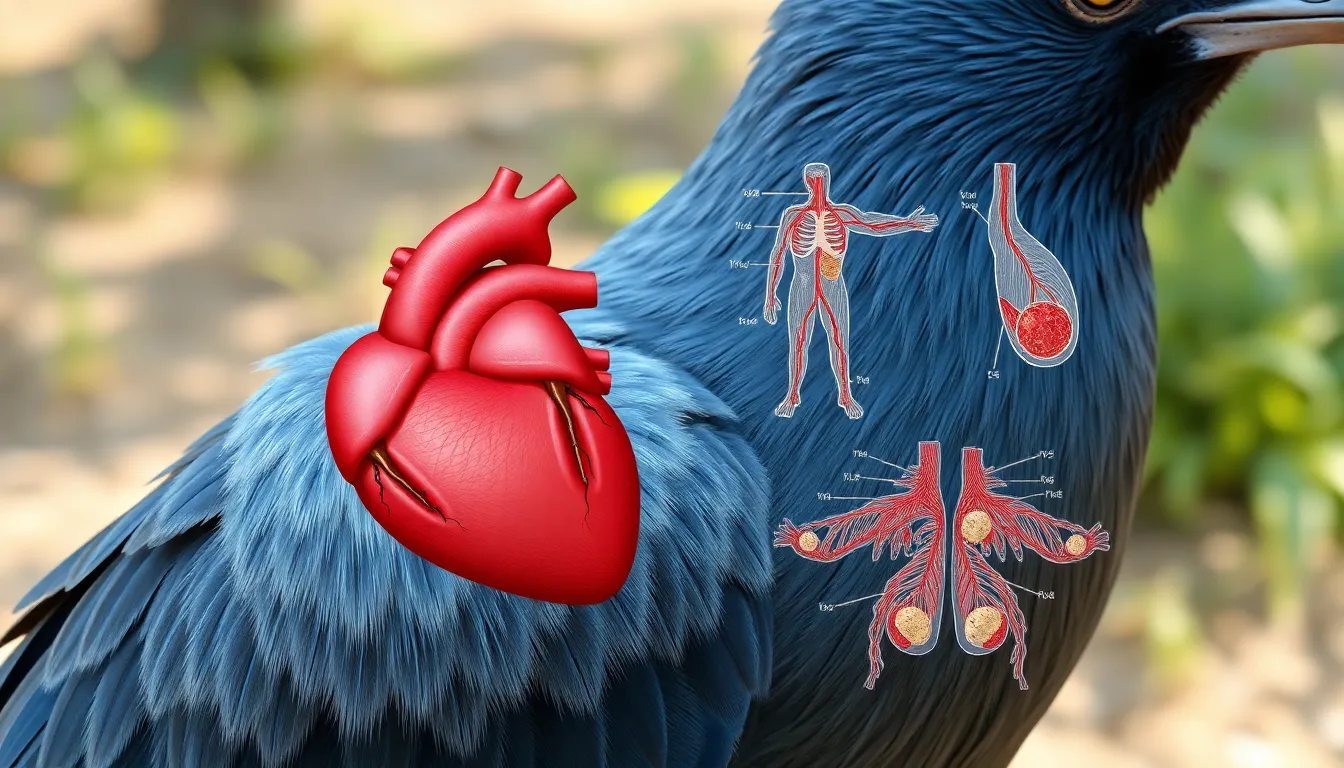
Bird cardiovascular systems demonstrate remarkable efficiency in supporting the demanding metabolic requirements of flight. These anatomical adaptations enable continuous oxygen delivery while maintaining optimal body temperature across diverse environments.
Heart Structure and Blood Flow
Birds possess a four-chambered heart that generates higher blood pressure than mammalian hearts of comparable size. The heart comprises two atria and two ventricles with complete separation between oxygenated and deoxygenated blood circulation.
Cardiac output in birds exceeds mammalian rates by 2-3 times relative to body mass. Small songbirds maintain heart rates between 400-1000 beats per minute during flight while larger raptors sustain 150-300 beats per minute. The right ventricle pumps blood through pulmonary circulation to the lungs and air sacs. Left ventricular contractions deliver oxygenated blood through systemic circulation to flight muscles and organs.
Blood vessels in birds feature specialized adaptations for flight demands. Arterial walls contain more elastic fibers than mammalian counterparts to accommodate rapid pressure changes during wing beats. Capillary density in flight muscles reaches 2000-3000 per square millimeter compared to 300-400 in mammalian skeletal muscle.
| Circulatory Feature | Small Birds | Large Birds |
|---|---|---|
| Heart Rate (flight) | 400-1000 bpm | 150-300 bpm |
| Blood Pressure | 180-200 mmHg | 160-180 mmHg |
| Capillary Density | 3000/mm² | 2500/mm² |
| Hematocrit Level | 45-55% | 40-50% |
Red blood cell count in birds exceeds mammalian levels with hematocrit values ranging from 40-55%. These cells contain higher hemoglobin concentrations and demonstrate greater oxygen-binding affinity at varying altitudes.
Temperature Regulation
Avian circulatory systems maintain core body temperatures between 104-108°F through sophisticated thermoregulatory mechanisms. Counter-current heat exchange systems in extremities prevent heat loss during cold exposure while specialized blood vessel arrangements help cooling during hot conditions.
Arterial and venous blood vessels run parallel in legs and wings creating heat exchange networks. Warm arterial blood transfers heat to returning venous blood before reaching core circulation. This arrangement reduces heat loss by 85-90% in exposed extremities during winter conditions.
Blood flow redistribution occurs through vasoconstriction and vasodilation responses to temperature changes. Peripheral vessels constrict during cold exposure directing blood flow to vital organs. Conversely warm conditions trigger vasodilation in skin blood vessels promoting heat dissipation through radiation and convection.
Specialized rete mirabile structures in beaks and legs contain hundreds of parallel blood vessels arranged in tight bundles. These networks function as biological heat exchangers maintaining optimal temperatures in appendages while conserving core body heat. Arctic species like snowy owls demonstrate enhanced rete development with vessel counts exceeding 500 per bundle.
Metabolic heat production increases during cold stress through enhanced circulation to brown fat deposits and flight muscle tissues. Shivering thermogenesis activates when ambient temperatures drop below thermoneutral zones typically ranging from 68-86°F depending on species size and plumage density.
Digestive System Components

The avian digestive system represents one of nature’s most efficient processing mechanisms, converting food into energy with remarkable speed and efficiency. These anatomical adaptations directly support the high metabolic demands of flight and enable birds to thrive in diverse ecological niches.
Beak Adaptations for Different Diets
Beak morphology determines feeding efficiency across avian species, with shapes evolved to match exact dietary requirements. Seed-eating finches possess thick, conical beaks measuring 8-15mm in length that generate crushing forces up to 70 pounds per square inch. Nectar-feeding hummingbirds display elongated, slender beaks reaching 20-100mm that access deep flower corollas with precision.
Carnivorous raptors feature hooked beaks with sharp edges measuring 15-40mm in curve radius, designed for tearing flesh and crushing bone. Fish-eating birds like herons exhibit straight, dagger-like beaks spanning 80-150mm that spear prey with surgical accuracy. Filter-feeding waterfowl possess broad, flattened beaks containing lamellae structures that strain microscopic organisms from water.
Insectivorous species showcase diverse beak adaptations including the aerial insect-catching flycatchers with wide, bristle-lined beaks measuring 12-18mm across the gape. Probing insectivores like woodpeckers feature chisel-shaped beaks extending 25-60mm with reinforced tips for bark penetration. Ground-foraging species display medium-length, slightly curved beaks optimal for extracting invertebrates from soil and leaf litter.
Crop, Gizzard, and Intestinal Function
Crop storage capacity varies significantly among species, ranging from 2-3ml in small songbirds to 300ml in large waterfowl like geese. Granivorous birds use this expandable chamber to store seeds temporarily, allowing rapid feeding followed by gradual processing. Pigeons and doves produce crop milk containing 60% water, 13% protein, and 7% fat to nourish developing chicks.
Gizzard muscle walls generate grinding forces between 50-200 pounds per square inch using ingested grit particles as millstones. Seed-eating birds maintain gizzard weights comprising 3-5% of total body mass compared to 1-2% in carnivorous species. Turkey gizzards process hard objects including glass marbles and metal objects through sustained muscular contractions.
Intestinal length correlates directly with dietary complexity, measuring 2-4 times body length in carnivores versus 6-11 times in herbivores. Small intestine surface area increases through villi projections that enhance nutrient absorption by factors of 15-30 compared to smooth surfaces. Transit times vary from 45 minutes in hummingbirds to 12 hours in large herbivorous waterfowl.
Cecal pouches help bacterial fermentation of plant matter, containing specialized microorganisms that break down cellulose into digestible compounds. Grouse and ptarmigan possess paired ceca measuring 15-25cm in length that process 20-30% of daily fiber intake. pH levels throughout the digestive tract range from 1.5-2.5 in the proventriculus to 6.5-7.5 in the ceca, optimizing enzymatic activity at each processing stage.
Nervous System and Sensory Organs

Birds possess sophisticated nervous systems that coordinate complex flight behaviors and process environmental information with remarkable precision. These neurological adaptations enable birds to navigate vast distances, execute intricate aerial maneuvers, and respond rapidly to environmental changes.
Brain Structure and Intelligence
Avian brains exhibit remarkable specialization even though their compact size, with brain-to-body mass ratios comparable to primates in many species. The cerebrum comprises 75% of total brain volume in songbirds, significantly larger than the 30% found in reptiles. Corvids like ravens and crows demonstrate problem-solving abilities that rival those of great apes, utilizing tools and understanding cause-and-effect relationships.
Songbird brains contain specialized nuclei called the song system, which controls vocal learning and production through interconnected brain regions including HVC (used as proper name), RA (robust nucleus of the arcopallium), and Area X. These structures undergo seasonal changes, with some nuclei increasing by 76% during breeding seasons in species like canaries.
Migratory birds possess enlarged hippocampi that store spatial memory maps essential for navigation across thousands of miles. Clark’s nutcrackers cache up to 33,000 pine seeds annually and retrieve them months later using precise spatial memory encoded in hippocampal neurons.
The optic tectum processes visual information and coordinates rapid flight responses, occupying 15-20% of total brain volume in raptors compared to 2% in mammals. Hummingbirds demonstrate exceptional spatial memory through enlarged hippocampi that help them remember the locations of hundreds of flowers across their territories.
Vision, Hearing, and Balance
Avian visual systems surpass mammalian capabilities in resolution, color perception, and motion detection. Birds process visual information at rates 2-3 times faster than humans, with flicker fusion frequencies reaching 146 Hz in pied flycatchers compared to 24 Hz in humans. Most bird species perceive ultraviolet light through specialized cone cells, revealing plumage patterns invisible to human eyes.
Raptor eyes contain 1 million photoreceptors per square millimeter, providing visual acuity 8 times sharper than human vision. Peregrine falcons track prey during 240 mph dives using nictitating membranes that protect eyes while maintaining clear vision. Owls possess asymmetrically positioned ear openings that create precise sound triangulation, enabling them to locate prey in complete darkness with accuracy within 1-2 degrees.
The vestibular system coordinates balance through semicircular canals filled with endolymph that detects rotational movements during flight. Hummingbirds maintain hover stability through vestibular organs that process acceleration changes within milliseconds. Pigeons use magnetic fields detected through magnetite crystals in their beaks and specialized neurons in their trigeminal system for navigation.
Hearing ranges vary dramatically among species, with barn owls detecting frequencies from 200 Hz to 12 kHz optimized for rodent vocalizations. Penguins communicate underwater using frequencies between 100-4000 Hz that travel efficiently through aquatic environments. The cochlea length correlates with frequency range, measuring 11mm in barn owls compared to 2.5mm in chickens.
Reproductive System Anatomy

Bird reproductive anatomy demonstrates remarkable efficiency and specialization compared to other vertebrates. These systems optimize reproductive success while maintaining flight capability through weight reduction and seasonal adaptations.
Internal Reproductive Organs
Female birds possess a highly specialized reproductive tract designed for egg production and minimal weight burden. The left ovary remains functional in most species while the right ovary regresses during development to reduce body mass. This functional ovary contains thousands of follicles that develop into ova during breeding season.
The oviduct extends approximately 25-30 centimeters in most songbirds and consists of five distinct regions. The infundibulum captures released ova and serves as the fertilization site. Magnum secretes albumin proteins around the developing egg over 3-4 hours. The isthmus adds shell membranes through calcium carbonate deposition.
Shell gland or uterus completes eggshell formation through a 20-24 hour process in most species. This chamber deposits calcium carbonate crystals in organized layers while adding pigments that create species-exact coloration patterns. The vagina connects the uterus to the cloaca for egg laying.
Male birds exhibit simplified reproductive anatomy optimized for flight efficiency. Paired testes increase in size by 100-500 times during breeding season depending on species. The vas deferens connects each testis to the cloaca through muscular tubes that store sperm temporarily.
Most bird species lack external reproductive organs. Males transfer sperm through cloacal contact during a brief mating process called cloacal kiss. Waterfowl and ratites represent exceptions with modified phallus structures for internal fertilization.
Egg Formation and Development
Egg formation follows a precise timeline that varies among species but maintains consistent developmental stages. Primary oocytes complete meiosis I when ovulation triggers occur through hormonal signals. Luteinizing hormone surges initiate follicle rupture and ova release into the infundibulum.
Fertilization occurs within 15-20 minutes of ovulation if sperm are present in the oviduct. Sperm storage tubules in the uterovaginal junction maintain viable sperm for 7-14 days in most songbirds and up to 117 days in domestic turkeys. This storage system allows females to produce fertile eggs from single mating events.
Albumen secretion begins in the magnum where four distinct protein layers form around the fertilized ovum. Ovomucin creates thick albumen near the yolk while ovotransferrin provides antimicrobial protection. Lysozyme adds additional bacterial resistance during the 3-hour transit through this region.
Shell membrane formation occurs in the isthmus over 1-2 hours as organic fibers create a foundation for calcium deposition. These membranes contain approximately 10,000 pores per square centimeter that regulate gas exchange during incubation. Inner and outer membranes separate at the blunt end to form the air cell.
Calcium carbonate crystallization in the shell gland creates eggshell strength through calcite crystal organization. Shell thickness varies from 0.2 millimeters in hummingbird eggs to 1.5 millimeters in ostrich eggs based on species requirements. Porphyrins and other pigments deposit during final shell formation to create species-exact patterns and colors.
Completed eggs contain all nutrients necessary for embryonic development including proteins, lipids, carbohydrates, vitamins, and minerals. Yolk composition reflects maternal diet and species-exact requirements with fat content ranging from 33% in shorebird eggs to 60% in seabird eggs.
Feather Structure and Types
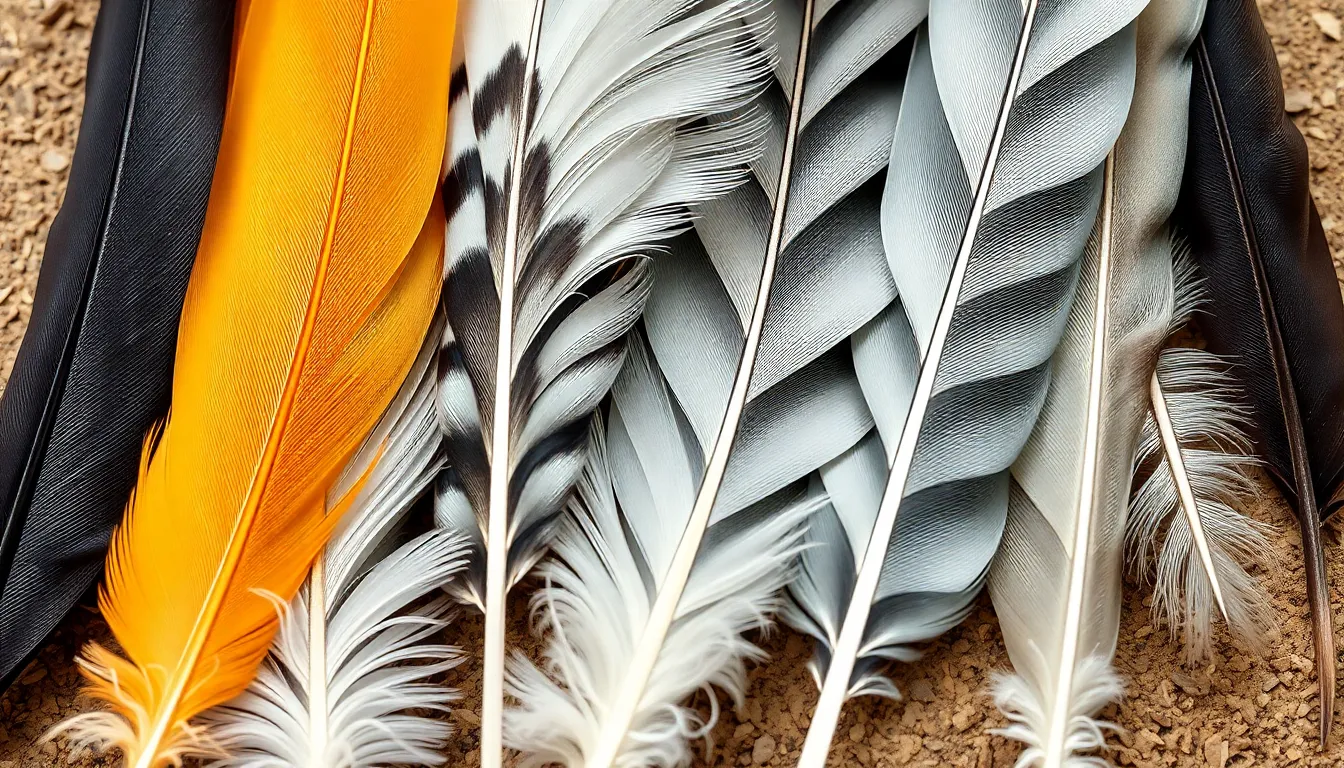
Feathers represent one of nature’s most sophisticated integumentary structures, providing birds with essential capabilities for flight, insulation, and display. We examine the intricate architecture of these specialized structures that define avian anatomy and enable aerial mastery.
Flight Feathers vs Down Feathers
Flight feathers form the primary structural components that generate lift and provide directional control during flight. These asymmetrical feathers feature a rigid central shaft called the rachis, with tightly interlocked barbs that create smooth, impermeable surfaces. Primary flight feathers extend from the wing tips and measure 15-30 centimeters in large raptors, while secondary feathers attach along the trailing edge of the wing. Tail feathers, numbering 12-14 in most species, function as rudders and brakes during aerial maneuvers.
Down feathers create the insulating layer closest to the bird’s skin, trapping warm air through their fluffy, three-dimensional structure. These feathers lack the rigid rachis found in flight feathers and instead feature soft, branched barbs that radiate from a short central shaft. Waterfowl possess the highest density of down feathers, with ducks maintaining approximately 14,000 down feathers per square inch on their breast area. Contour feathers bridge the gap between flight and down feathers, providing the streamlined outer surface while offering moderate insulation properties.
| Feather Type | Length Range | Primary Function | Structural Features |
|---|---|---|---|
| Flight Feathers | 15-30 cm | Lift generation, steering | Asymmetrical, rigid rachis, interlocked barbs |
| Down Feathers | 1-3 cm | Insulation | Fluffy structure, branched barbs, short shaft |
| Contour Feathers | 2-8 cm | Streamlining, moderate insulation | Smooth outer surface, some down-like base |
Molting and Feather Replacement
Molting occurs as a systematic process where birds replace worn feathers with new ones, maintaining optimal flight performance and insulation capacity. Most songbirds complete their molt over 6-12 weeks during late summer, shedding feathers in a precise sequence that preserves flight capability throughout the process. Waterfowl experience a complete simultaneous molt of flight feathers, rendering them temporarily flightless for 3-5 weeks while new feathers develop.
Feather replacement follows species-exact patterns that balance energy requirements with survival needs. Raptors molt flight feathers gradually over 12-18 months, replacing 2-3 primary feathers per wing annually to maintain hunting efficiency. Arctic terns undergo two complete molts per year, adapting their plumage for both breeding and non-breeding seasons during their 44,000-mile annual migration. Stress hormones including corticosterone regulate molting timing, with elevated levels potentially disrupting the normal replacement schedule and affecting feather quality.
Energy demands during molt increase metabolic rates by 15-20% above baseline levels, requiring birds to consume additional protein for keratin synthesis. Amino acid availability directly influences feather quality, with methionine and cysteine serving as essential building blocks for strong, flexible feather structures. Environmental factors such as temperature, daylight duration, and food availability trigger hormonal cascades that initiate molting cycles across different species.
Conclusion
Understanding bird anatomy reveals nature’s most sophisticated engineering answers. We’ve explored how every system works in perfect harmony to enable flight and survival across diverse environments.
These remarkable adaptations continue to inspire human innovation in aerospace engineering biotechnology and materials science. From hollow bones to unidirectional airflow systems birds demonstrate efficiency that we’re still learning to replicate.
Whether you’re a wildlife enthusiast conservationist or simply curious about nature appreciating avian anatomy deepens our connection to these incredible creatures. Their evolutionary mastery reminds us that form truly follows function in the natural industry.
Frequently Asked Questions
What makes bird bones different from mammal bones?
Bird bones are hollow (pneumatic) and filled with air sacs, making them significantly lighter than mammal bones while maintaining structural strength. This unique design reduces body weight by up to 20% compared to solid bones, which is crucial for flight. The hollow structure doesn’t compromise durability, as birds have evolved strategic reinforcements in high-stress areas.
How do birds breathe so efficiently during flight?
Birds have a unique unidirectional airflow system with 9 interconnected air sacs that ensure continuous oxygen delivery. Unlike mammals who breathe in and out through the same passages, birds move air in one direction through their lungs, achieving 85-90% oxygen extraction rates. This system synchronizes with wing beats to maximize ventilation efficiency.
Why do birds have different beak shapes?
Beak shapes reflect specialized feeding adaptations evolved over millions of years. Seed-eating finches have thick, conical beaks for cracking shells, while nectar-feeding hummingbirds have elongated, thin beaks to reach deep into flowers. Each shape represents an evolutionary solution to accessing specific food sources efficiently in their ecological niche.
How do flight muscles work in birds?
Birds have two primary flight muscles: the pectoralis major (downstroke) and supracoracoideus (upstroke), comprising up to 35% of body weight in strong fliers. These muscles contain fast-twitch fibers for rapid wing beats and coordinate with respiratory muscles to maintain oxygen flow. Smaller muscle groups provide precise control for maneuvering and landing.
What is the purpose of different feather types?
Birds have three main feather types serving distinct functions. Flight feathers provide lift and thrust, down feathers offer insulation by trapping warm air, and contour feathers create the bird’s streamlined shape and waterproofing. Each type has specific structural features optimized for its role in flight, thermoregulation, or protection.
How do birds maintain body temperature during flight?
Birds maintain core body temperature through sophisticated circulatory adaptations including counter-current heat exchange systems in their legs and wings. Blood flow redistribution directs warm blood to essential organs while allowing extremities to cool slightly. Their high metabolic rate and efficient insulation from down feathers help regulate temperature across varying altitudes and weather conditions.
Why do birds have such good eyesight?
Avian eyes are proportionally larger than mammalian eyes and contain specialized structures like the pecten for enhanced blood supply. Birds can see ultraviolet light and detect rapid motion better than humans. Their eyes often have more photoreceptors and can process visual information faster, which is essential for navigation, predator detection, and precise flight control.
How does the bird digestive system support flight?
The avian digestive system is highly efficient, featuring a crop for food storage, a muscular gizzard for grinding, and varying intestinal lengths based on diet complexity. This system quickly converts food to energy needed for flight’s high metabolic demands. The lightweight design eliminates teeth and reduces digestive organ size while maintaining nutritional efficiency.

